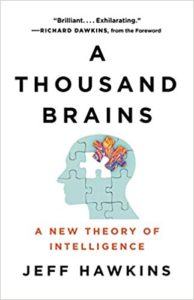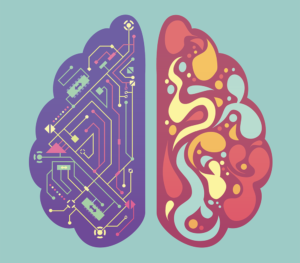A Thousand Brains

BY JEFF HAWKINS
BASIC BOOKS, 2021
Many of us wonder at how our brains work—and we are often even more puzzled about how the brains of other people work. Jeff Hawkins’ new book, A Thousand Brains, introduces his ideas on the subject, written in a vigorous and engaging style. While the enthusiasm and ideas are clearly Hawkins’, I suspect the engaging language owes a good deal to Christie Mavor, the VP of marketing at Hawkins’ company whose editing is acknowledged briefly at the end.
Jeff Hawkins was one of the first to predict that hand-held computers would become so useful that they would insinuate themselves (as smartphones) into everyone’s pocket. He designed the Palm Pilot, founded a company to build it, and made a fortune. He has used his fortune from Palm to fund his quest to understand the human brain.
It seems that every week we read about a new study of the brain, but somehow, after decades of research, we are still in the dark about the basic question: how cells and electricity give rise to love, hate, and thought. Scientists now have a wealth of details about specific aspects of the brain, but how it actually accomplishes the wonders we take for granted in daily life remains profoundly mysterious. On the second page of the book, Hawkins quotes Francis Crick to introduce the fundamental issue: “what is conspicuously lacking is a broad framework of ideas in which to interpret these results.” Hawkins proposes an analogy: we are assembling a gigantic puzzle with untold thousands of pieces but no master plan, and we have no idea what the final picture is supposed to look like. In this book, Hawkins proposes a set of ideas that he thinks will be the key to synthesizing all of the details into a coherent picture.
 The title of the book comes from the idea that the cortex—the dense grey matter covering the whole surface of the brain—seems to be composed of many repeated thin columns of microcircuits packed together side-by-side (actually, the number is about 150,000 rather than 1,000, but that’s not such a memorable title). He imagines that each of these columns has a good deal of innate ability (intelligence), but only very partial information; the cortical columns work together to arrive at a consensus about how the world works.
The title of the book comes from the idea that the cortex—the dense grey matter covering the whole surface of the brain—seems to be composed of many repeated thin columns of microcircuits packed together side-by-side (actually, the number is about 150,000 rather than 1,000, but that’s not such a memorable title). He imagines that each of these columns has a good deal of innate ability (intelligence), but only very partial information; the cortical columns work together to arrive at a consensus about how the world works.
Hawkins divides the book into three parts. The long first part introduces his theory of reference frames, which he calls “thousand brains theory.” The second part of the book wrestles with the issue of machine intelligence and how that might be achieved using his idea. The third part of the book is perhaps of the broadest interest to humanists: he discusses the human condition from a brain science perspective. In his final chapter, he discusses some current critical issues for humanity.
The first section of the book is part intellectual biography and part argument for his point of view. He describes how several of his key ideas occurred to him and then marshals evidence from the neuroscience literature to support those ideas. He goes on to describe the work that his company has done to try to simulate brain processes using these ideas.
The first key idea is that the cortex is composed of many repeating units. The cortex is about two and a half millimeters (1/10 inches) thick and it seems that the strongest connections run vertically from cells in the upper layers to those in the bottom and back. This leads many scientists to think that the cortex is parceled into mini columns, each about a millimeter across, which function semi-independently. You may think of these as identical linked minicomputers: each minicomputer gets inputs from several dozen other minicomputers and sends output to several dozen others. The minicomputers each function in the same way, but the distinctive inputs to each of those minicomputers gives each one the data on which it alone works.
Hawkins then explains how he thinks that these mini-column circuits work using two metaphors. The first metaphor is the idea of the cortical column as a prediction engine. He notes that the upper dendrites of major output neurons integrate inputs from other cortical areas. He suggests that those inputs prepare a few major neurons to fire, while repressing most others, but ultimately don’t fire them. The sensory input pushes those prepared neurons over the top—if that input is consistent with the pattern ‘predicted’ by the other neurons. If not, then the system is imbalanced and many neurons fire, drawing attention to the discrepancy.
The idea of the cortex as a predictor is the subject of his previous book, on intelligence. Hawkins has updated the idea for this book by recasting it in terms of the neocortex learning ‘a model’ of the world, or more precisely, a model of each of the distinct components of the world.
The second metaphor is the idea of reference frames. Hawkins builds on recent work by two Norwegian neuroscientists (who won a Nobel Prize in 2014), showing that some cells seem to fire at regularly spaced intervals as an animal moves. Some evidence cited in the book suggests that, in human beings, such cells may help organize our knowledge in several dimensions by firing at regular intervals as our minds move metaphorically in ‘concept space.’
He spends most of the book’s first section describing how a cortical microcircuit within a small column may function. He proposes that all cortical columns predict their individual sets of expectations about what comes next, based on their own partial information, and that they arrive at some consensus by a process similar to voting.
A recurrent theme is his criticism of the establishment point of view: the dominant metaphor, even today, is the idea of the brain as a computer. If you take away nothing else from this book, the idea of the brain as a dynamic organ, ever-shifting in its posture, should replace the commonly used ‘information processing’ metaphor—as if thought were a succession of filing clerks funneling information up the chain of command.
In the second section, Hawkins discusses why general-purpose flexible artificial intelligence (AI) is still a long way off, despite the sweeping success of special purpose machine learning tools. He proposes several ideas about how AI might come about, what it might do for us, and whether or not it may be a good thing for humanity. Not surprisingly, he believes that true general-purpose artificial intelligence will only come about when computers can simulate something like his model of the cortex. He addresses whether an intelligent machine could be considered conscious and whether machine intelligence could overthrow humanity. (He thinks not.) This section sets out briefly and engagingly some of the technical and ethical issues that artificial intelligence people wrestle with.
The third section of the book discusses existential issues for humanity and our technology. He spends a chapter on the proliferation of false beliefs. Then he discusses whether we could upload our consciousness onto a computer, or perhaps merge with a computer, as portrayed in many works of science-fiction. (He thinks it will be much harder than often assumed.) This section uses some neuroscience language but does not make much use of his specific brain theory. Most humanists will find this section agreeable and well-written, but not original; the ideas are similar to what many other secular intellectuals say about these topics.
What can you learn from this book? Hawkins introduces some exciting ideas at the forefront of neuroscience research. Although this is my own area of research, I found the book stimulating and informative. However, I don’t agree that he’s found ‘the big picture’ in the puzzle for three reasons as follows.
First, although Hawkins calls the neocortex the engine of intelligence and disparages the ‘old brain’ at the core, the cortex is strongly and intimately interconnected with the ‘old brain,’ and it is hard to see how they could function separately. It’s perhaps more correct to think of the cortex as an add-on to the central and more primitive areas of the brain, similarly to how the many cores of a GPU greatly enhance the power of a CPU for many kinds of specific tasks but don’t function on their own.
Bird neuroscientists argue that the cortex isn’t such an efficient way to have intelligence at all. With their nut-sized brains, birds are capable of some very intelligent activities but do so entirely without a cortex, utilizing their circuitry much more efficiently. Some argue that the repeated modular organization of the cortex, with its many repeating units, is a genetically efficient way to generate during embryonic development varying amounts (in our case a lot) of general-purpose brain tissue but is not the optimal way to produce intelligence.
Second, Hawkins works hard to explain how the mini-columns may work, but only toward the end of the first section do we get a rather vague page and a half explaining how they may all be connected into a single brain by ‘voting.’ Recent recordings show that there are specific correlations between different neurons in very distant cortical areas, suggesting that circuitry across mini-columns is as important as circuitry within them.
Third, when discussing how human beings learn “predictive models” of the world, Hawkins takes for granted an individualistic framework; he speaks entirely in terms of a person’s own perceptions and feedback from the experience. He says nothing about how social learning and relationships help shape (and distort) one’s perception of the world.
While my interpretations of the data are quite different from those of the author, I found the book energizing and educational. The foreward says that it is an exhilarating book and you should not read it just before going to bed. If you are a science nerd, then I would agree.
